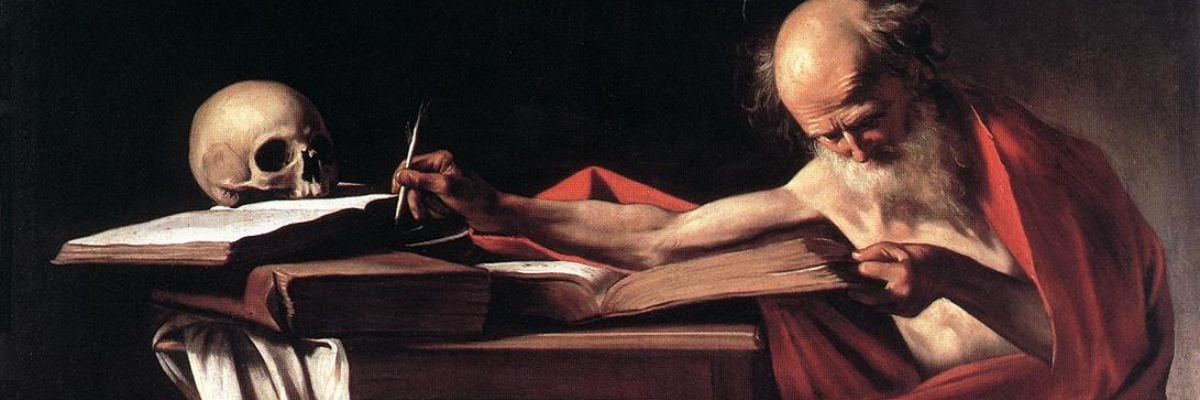
Saint Jerome was probably the most learned of the early Church fathers. His mastery of ancient languages made him the greatest Scripture scholar the Church has produced. During the philological revival of the Renaissance he was widely regarded as the ideal scholar, and his translation of the Bible helped earn him the title Doctor of the Church.
But he was more than a scholar. He was a brilliant apologist from whom modern apologists (including budding apologists) can learn. Especially valuable are his works in defense of the perpetual virginity of Mary, a doctrine disputed in the fourth century as in the twentieth.
Jerome was born Eusebius Hieronymus Sophronius about 345 in what is now northern Italy. His Christian parents raised him in the faith and sent him to Rome at the age of twelve to study rhetoric and grammar. He excelled in his studies of Latin and Greek and came in contact with a group of ascetics whose practices would influence the remainder of his life. Pope Liberius baptized him in 360.
Fourteen years later Jerome journeyed to Syria, where he lived among a community of hermits. He devoted most of his time to studying Hebrew and Greek. Meanwhile, the Meletian schism broke out in Antioch. Jerome wrote several letters to Pope Damasus in support of Bishop Paulinus. Later, in Syria, Jerome was ordained to the priesthood.
After a serious illness, he had a vision in which he was brought before the judgment seat of God and asked to identify himself. He responded that he was a Christian, but the Lord said, “You are lying. You are a Ciceronian, for where your treasure is, there is your heart also.” The experience had such a profound effect on Jerome that he retired to the desert for several years of solitary prayer and fasting. He re-emerged in order to study Scripture under Gregory Nazianzen at Constantinople.
In 382 he went to Rome with Epiphanius to attend a council convened to address the schism raging in Antioch. He remained there as secretary to Pope Damasus, at whose request he revised the Latin gospels, Paul’s letters, and the psalms. Noteworthy for modern apologists is his Adversus Helvidium, which attacked Helvidius for claiming Mary had several children besides Jesus. Jerome claimed that Helvidius’s position (which matches the position of today’s Evangelicals and Fundamentalists) was a novelty unknown to earlier generations of Christians.
While in Rome Jerome organized and directed a community of ascetics made up of noble women. Upon the death of his patron, Pope Damasus, in 384, Jerome returned to the Holy Land with a group of loyal followers, including Paula (later canonized). They eventually settled in Bethlehem, opening a hospice, a monastery, several convents, and a school, where Jerome taught Greek and Latin.
He spent most of his time translating the entire Bible from the original languages into Latin, the language of the former Empire, basing his work largely on Old Latin texts. The Vulgate, as his version was thereafter called, was completed in 405. It was the official Latin text of the Bible until Pope John Paul II replaced it with the New Vulgate in 1979.
Jerome did not confine himself to biblical work. He found time for apologetical writings, such as Adversus Jovinianum, which refuted Jovinian’s belief that Mary had other children, and Contra Vigilantium, which attacked Vigilantius’s condemnation of the veneration of relics.
Jerome was a contradictory man. He possessed a great personal holiness, which was always evident to his friends, but his sarcastic wit was easily provoked. He was ruthless in his polemical attacks on enemies of the Church. He even vented his anger at Augustine when Augustine questioned his exegesis of part of Paul’s Letter to the Romans. Looking at a picture of Jerome beating his chest with a stone, Pope Sixtus V reportedly remarked, “You do well to use that stone; without it you would never have been numbered among the saints.”
Until his death in 420, Jerome was occupied condemning the Pelagian heresy and writing a series of commentaries on the Bible. He fled Jerusalem when Pelagian monks attacked and burned his monastery. He died in Bethlehem and was buried under the Church of the Nativity, but his body later was moved to St. Mary Major in Rome.


